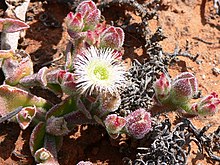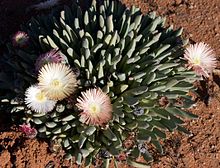| Aizoaceae | |
|---|---|

| |
| Mesembryanthemum crystallinum | |
| Scientific classification | |
| Kingdom: | Plantae |
| Clade: | Tracheophytes |
| Clade: | Angiosperms |
| Clade: | Eudicots |
| Order: | Caryophyllales |
| Family: | Aizoaceae Martinov |
| Type genus | |
| Aizoon L. | |
| Genera | |
|
See text | |
| Synonyms | |
| |
The Aizoaceae (/eɪzoʊˈeɪsiːˌiː, -siˌaɪ/), or fig-marigold family, is a large family of dicotyledonous flowering plants containing 135 genera and about 1,800 species. Several genera are commonly known as 'ice plants' or 'carpet weeds'. The Aizoaceae are also referred to as vygies in South Africa. Some of the unusual Southern African genera—such as Conophytum, Lithops, Titanopsis and Pleiospilos (among others)—resemble gemstones, rocks or pebbles, and are sometimes referred to as 'living stones' or 'mesembs' (short for mesembryanthemums).
Description

The family Aizoaceae is widely recognised by taxonomists. It once went by the botanical name "Ficoidaceae", now disallowed. The APG II system of 2003 (unchanged from the APG system of 1998) also recognizes the family, and assigns it to the order Caryophyllales in the clade core eudicots. The APG II system also classes the former families Mesembryanthemaceae Fenzl, Sesuviaceae Horan. and Tetragoniaceae Link under the family Aizoaceae.
The common Afrikaans name "vygie" meaning "small fig" refers to the fruiting capsule, which resembles the true fig. Glistening epidermal bladder cells give the family its common name "ice plants".
Most species (96%, 1782 species in 132 genera) in this family are endemic to arid or semiarid parts of Southern Africa in the Succulent Karoo. Much of the Aizoaceae's diversity is found in the Greater Cape Floristic Region, which is the most plant-diverse temperate region in the world. A few species are found in Australia and the Central Pacific area.
Most fig-marigolds are herbaceous, rarely somewhat woody, with sympodial growth and stems either erect or prostrate. Leaves are simple, opposite or alternate, and more or less succulent with entire (or rarely toothed) margins. Flowers are perfect in most species (but unisexual in some), actinomorphic, and appear singularly or in few-flowered cymes developing from the leaf axils. Sepals are typically five (3–8) and more or less connate (fused) below. True petals are absent. However, some species have numerous linear petals derived from staminodes. The seed capsules have one to numerous seeds per cell and are often hygrochastic, dispersing seeds by "jet action" when wet.
Evolution
The radiation of the Aizoaceae, specifically the subfamily Ruschioideae, was one of the most recent among the angiosperms, occurring 1.13–6.49 Mya. It is also one of the fastest radiations ever described in the angiosperms, with a diversification rate of about 4.4 species per million years. This diversification was roughly contemporaneous with major radiations in two other succulent lineages, Cactaceae and Agave.
The family includes many species that use crassulacean acid metabolism as pathway for carbon fixation. Some species in the subfamily Sesuvioideae instead use C4 carbon fixation, which might have evolved multiple times in the group.
Taxonomy

Because of the hyperdiversity of the Aizoaceae and the young age of the clade, many generic and species boundaries are uncertain.







Subfamily Acrosanthoideae
Genera:
- Acrosanthes Eckl. & Zeyh.
Subfamily Aizooideae
Genera:
- Aizoanthemopsis Klak
- Aizoanthemum Dinter ex Friedrich
- Aizoon L.
- Gunniopsis Pax
- Tetragonia L.
Subfamily Mesembryanthemoideae
Genera:
|
|
Subfamily Ruschioideae
Genera:
|
* no longer recognised |
- Tribe Ruschieae
- Acrodon N.E.Br
- Aloinopsis Schwantes
- Amphibolia L.Bolus ex A.G.J.Herre
- Antegibbaeum Schwantes ex C.Weber
- Antimima N.E.Br
- Arenifera Herre, synonym of Mesembryanthemum
- Argyroderma N.E.Br
- Astridia Dinter
- Bergeranthus Schwantes
- Bijlia N.E.Br, synonym of Pleiospilos
- Braunsia Schwantes
- Brianhuntleya Chess. et al.
- Carpobrotus N.E.Br
- × Carruanthophyllum G.D.Rowley (Carruanthus × Machairophyllum)
- Carruanthus (Schwantes) Schwantes
- Cephalophyllum N.E.Br
- Cerochlamys N.E.Br
- Chasmatophyllum Dinter & Schwantes
- Cheiridopsis N.E.Br
- Circandra N.E.Br
- Conophytum N.E.Br
- Corpuscularia Schwantes, synonym of Delosperma
- Cylindrophyllum Schwantes
- Delosperma N.E.Br
- Dicrocaulon N.E.Br
- Didymaotus N.E.Br
- Dinteranthus Schwantes
- Diplosoma Schwantes
- Disphyma N.E.Br
- Dracophilus (Schwantes) Dinter & Schwantes
- Drosanthemum Schwantes
- Eberlanzia Schwantes
- Ebracteola Dinter & Schwantes
- Ectotropis N.E.Br, synonym of Delosperma
- Enarganthe N.E.Br
- Erepsia N.E.Br
- Esterhuysenia L.Bolus
- Faucaria Schwantes
- Fenestraria N.E.Br
- Frithia N.E.Br
- Gibbaeum Haw. ex N.E.Br
- Glottiphyllum Haw. ex N.E.Br
- Hallianthus H.E.K.Hartmann
- Hereroa (Schwantes) Dinter & Schwantes
- Ihlenfeldtia H.E.K.Hartmann, synonym of Cheiridopsis
- Imitaria N.E.Br, synonym of Gibbaeum
- Jacobsenia L.Bolus & Schwantes
- Jensenobotrya A.G.J.Herre
- Jordaaniella H.E.K.Hartmann
- Juttadinteria Schwantes
- Khadia N.E.Br
- Lampranthus N.E.Br
- Lapidaria (Dinter & Schwantes) N.E.Br.
- Leipoldtia L.Bolus
- Lemonanthemum Klak
- Lithops N.E.Br
- Machairophyllum Schwantes
- Malephora N.E.Br
- Malotigena Niederle
- Marlothistella Schwantes
- Mestoklema N.E.Br. ex Glen
- Meyerophytum Schwantes
- Mitrophyllum Schwantes
- Monilaria (Schwantes) Schwantes
- Mossia N.E.Br
- Muiria N.E.Br
- Namaquanthus L.Bolus
- Namibia (Schwantes) Schwantes
- Nananthus N.E.Br
- Nelia Schwantes
- Neohenricia L.Bolus
- Octopoma N.E.Br
- Odontophorus N.E.Br, synonym of Cheiridopsis
- Oophytum N.E.Br
- Orthopterum L.Bolus
- Oscularia Schwantes
- Ottosonderia L.Bolus
- Phiambolia Klak
- Pleiospilos N.E.Br
- Polymita N.E.Br, synonym of Schlechteranthus
- Psammophora Dinter & Schwantes
- Rabiea N.E.Br
- Rhinephyllum N.E.Br
- Rhombophyllum (Schwantes) Schwantes
- Roosia van Jaarsv.
- Ruschia Schwantes
- Ruschianthemum Friedrich, synonym of Stoeberia
- Ruschianthus L.Bolus
- Sarcozona J.M.Black
- Schlechteranthus Schwantes
- Schwantesia Dinter
- Scopelogena L.Bolus
- Smicrostigma N.E.Br
- Stayneria L.Bolus
- Stoeberia Dinter & Schwantes
- Stomatium Schwantes
- Tanquana H.E.K.Hartmann & Liede
- Titanopsis Schwantes
- Trichodiadema Schwantes
- Vanheerdea L.Bolus ex H.E.K.Hartmann
- Vanzijlia L.Bolus
- Vlokia S.A.Hammer
- Wooleya L.Bolus
- Zeuktophyllum N.E.Br
Subfamily Sesuvioideae
This subfamily includes a number of C4 species.
Genera:
- Anisostigma Schinz, synonym of Tetragonia
- Sesuvium L.
- Trianthema L.
- Tribulocarpus S.Moore
- Zaleya Burm.f.
Unplaced genera
Include;
Uses

Several genera are cultivated. Lithops, or "living stones", are popular as novelty house plants because of their stone-like appearance.
Some species are edible, including:
- Carpobrotus edulis (Hottentot fig, highway ice plant) has edible leaves and fruit.
- Mesembryanthemum crystallinum has edible leaves.
- Tetragonia tetragonoides ("New Zealand spinach") is grown as a garden plant in somewhat dry climates and used as an alternative to spinach in upscale salads.
C. edulis was introduced to California in the early 1900s to stabilize soil along railroad tracks and has become invasive. In southern California, ice plants are sometimes used as firewalls; however, they do burn if not carefully maintained.
References
- "Aizoaceae Martinov". Plants of the World Online. Royal Botanic Gardens, Kew. Retrieved 8 November 2022.
- Hartmann, HEK (2001). Illustrated Handbook of Succulent Plants. Berlin, Germany: Springer.
- "The Living Stone Page". The Succulent Plant Page. Retrieved 23 June 2017.
- ^ "Angiosperm Phylogeny Website". www.mobot.org. Retrieved 2017-12-20.
- Chesselet, P.; Smith, G.F.; Burgoyne, P.M.; et al. (2000). "Seed Plants of Southern Africa". Strelitzia. 10: 360–410.
- Born, J.; Linder, H. P.; Desmet, P. (2007). "The Greater Cape Floristic Region". Journal of Biogeography. 34 (1): 147–162. doi:10.1111/j.1365-2699.2006.01595.x. JSTOR 4125143.
- "Browsing: Aizoaceae". World of Succulents. Retrieved 23 June 2017.
- Watson, L.; Dallwitz, M.J. (1992). "The families of flowering plants: descriptions, illustrations, identification, and information retrieval". 20 June 2017. Retrieved 9 July 2017.
- ^ Valente, Luis M.; Britton, Adam W.; Powell, Martyn P.; Papadopulos, Alexander S. T.; Burgoyne, Priscilla M.; Savolainen, Vincent (2014-01-01). "Correlates of hyperdiversity in southern African ice plants (Aizoaceae)". Botanical Journal of the Linnean Society. 174 (1): 110–129. doi:10.1111/boj.12117. ISSN 0024-4074. PMC 4373134. PMID 25821244.
- Arakaki, Mónica; Christin, Pascal-Antoine; Nyffeler, Reto; Lendel, Anita; Eggli, Urs; Ogburn, R. Matthew; Spriggs, Elizabeth; Moore, Michael J.; Edwards, Erika J. (2011). "Contemporaneous and recent radiations of the world's major succulent plant lineages". Proceedings of the National Academy of Sciences of the United States of America. 108 (20): 8379–8384. Bibcode:2011PNAS..108.8379A. doi:10.1073/pnas.1100628108. JSTOR 25830059. PMC 3100969. PMID 21536881.
- ^ Bohley, Katharina; Joos, Olga; Hartmann, Heidrun; Sage, Rowan; Liede-Schumann, Sigrid; Kadereit, Gudrun (2015). "Phylogeny of Sesuvioideae (Aizoaceae) – Biogeography, leaf anatomy and the evolution of C4 photosynthesis". Perspectives in Plant Ecology, Evolution and Systematics. 17 (2): 116–130. doi:10.1016/j.ppees.2014.12.003. ISSN 1433-8319.
- "GRIN Genera of Aizoaceae subfam. 'Acrosanthoideae". Germplasm Resources Information Network. Retrieved 2022-11-10.
- "GRIN Genera of Aizoaceae subfam. Aizooideae". Germplasm Resources Information Network. Archived from the original on 2012-07-19. Retrieved 2011-03-04.
- "GRIN Genera of Aizoaceae subfam. Mesembryanthemoideae". Germplasm Resources Information Network. Archived from the original on 2012-07-18. Retrieved 2011-03-04.
- "GRIN Genera of Aizoaceae tribe Apatesieae". Germplasm Resources Information Network. Archived from the original on 2015-09-24. Retrieved 2011-03-04.
- "GRIN Genera of Aizoaceae tribe Dorotheantheae". Germplasm Resources Information Network. Archived from the original on 2012-07-24. Retrieved 2011-03-04.
- "GRIN Genera of Aizoaceae tribe Ruschiae". Germplasm Resources Information Network. Archived from the original on 2012-07-20. Retrieved 2011-03-04.
- "Mesembryanthemaceae - Ruschioideae - Ruschia Group Marlothistella". biodiversityadvisor.sanbi.org. Archived from the original on 22 October 2021. Retrieved 22 October 2021.
- "GRIN Genera of Aizoaceae subfam. Sesuvioideae". Germplasm Resources Information Network. Archived from the original on 2012-07-18. Retrieved 2011-03-04.
- ^ Facciola. S. (1990). Cornucopia - A Source Book of Edible Plants. Kampong Publications. ISBN 0-9628087-0-9.
- Low. T. (1989). Wild Food Plants of Australia. Angus and Robertson. ISBN 0-207-14383-8.
- "Invasive Plants of California's Wildland". California Invasive Plant Council. Retrieved 23 June 2017.
- "Fire Safe Landscaping". Cal Fire. Archived from the original on 2 July 2017. Retrieved 23 June 2017.
- Baldwin, Debra Lee. "Firewise Landscaping with Succulents - How succulents saved a Rancho Santa Fe home from wildfire". Retrieved 23 June 2017.
Further reading
- Volker Bittrich; Heidrun E. K. Hartman (1988). "The Aizoaceae—a new approach". Bot. J. Linn. Soc. 97 (3): 239–254. doi:10.1111/j.1095-8339.1988.tb01581.x.
- Cornelia Klak; Angeline Khunou; Gail Reeves; Terry Hedderson (2003). "A phylogenetic hypothesis for the Aizoaceae (Caryophyllales) based on four plastid DNA regions". Am. J. Bot. 90 (10): 1433–1445. doi:10.3732/ajb.90.10.1433. PMID 21659095.
External links
- Aizoaceae in L. Watson and M.J. Dallwitz (1992 onwards). The families of flowering plants
- NCBI Taxonomy Browser
- P. Chesselet (2004 onwards). Interactive Mesembs2
- Plants of southern Africa (2005 onwards). SANBI
- Aizoaceae of South Africa
- Family Aizoaceae Flowers in Israel
- Aizoaceae in BoDD – Botanical Dermatology Database
| Taxon identifiers | |
|---|---|
| Aizoaceae |
|